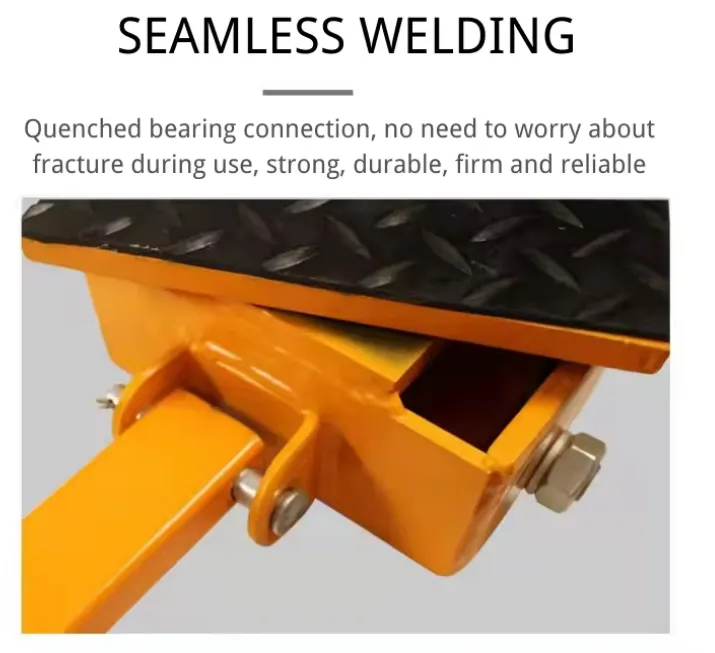Versatile Trolley for Efficient Transportation of Heavy Machinery and Equipment
The Versatility and Importance of the Machine Shifting Trolley
In the modern industrial landscape, efficiency and productivity are paramount. As businesses strive to optimize their operations, the role of transport and material handling solutions becomes crucial. Among these solutions, the machine shifting trolley stands out as an invaluable tool, facilitating the movement of heavy machinery and equipment within factories, warehouses, and construction sites. This article delves into the features, benefits, and applications of machine shifting trolleys, highlighting their significance in contemporary operations.
What is a Machine Shifting Trolley?
A machine shifting trolley, often referred to as a machinery dolly, is a specialized wheeled platform designed to assist in the relocation of heavy machinery and equipment. These trolleys are typically constructed from robust materials, such as steel or high-grade aluminum, ensuring durability and stability under hefty loads. They are equipped with a series of wheels, often with locking mechanisms, to provide both mobility and security during transport.
The design of machine shifting trolleys varies, but they generally include features such as adjustable platforms, pull handles, and sometimes hydraulic or mechanical jacks for lifting equipment off the ground. This versatility enables them to accommodate a wide range of machinery, from small engines to large industrial machines.
Benefits of Using a Machine Shifting Trolley
1. Increased Efficiency Moving heavy machinery manually is not only labor-intensive but also time-consuming. A machine shifting trolley significantly reduces the effort required to transport equipment, allowing workers to complete tasks more efficiently and focus on core operations.
2. Enhanced Safety The risk of injury when lifting or moving heavy objects is a concern in any industrial setting. Machine shifting trolleys minimize the need for manual lifting, thereby reducing the likelihood of strain injuries. Additionally, the presence of safety features, such as wheel locks, ensures stability during transport.
machine shifting trolley

3. Versatility These trolleys can be adapted for various applications across different sectors, including manufacturing, construction, and warehousing. Whether moving a lathe in a machine shop or relocating an assembly line, their flexibility makes them an essential asset in diverse environments.
4. Cost-Effectiveness While there is an initial investment required to purchase a machine shifting trolley, the long-term savings in labor costs and the reduction of damage to equipment can outweigh this expense. By streamlining the movement of heavy objects, businesses can enhance their overall productivity and reduce operational costs.
5. Space Management In many workplaces, space can be a premium. Machine shifting trolleys help in the effective use of available space by allowing easy repositioning of machinery and equipment. This flexibility enables companies to reorganize their layouts according to operational needs.
Applications of Machine Shifting Trolleys
Machine shifting trolleys are employed in various industries and settings. In manufacturing plants, they are commonly used to move CNC machines, lathes, and other heavy tools from one workstation to another. In warehouses, they assist in relocating large pallets and machinery as needed, making inventory management more effective.
Construction sites also benefit from these trolleys by facilitating the movement of heavy equipment such as generators, compressors, and mixers. Moreover, in maintenance and repair shops, they are indispensable for maneuvering machinery in and out of service areas.
Conclusion
In summary, the machine shifting trolley plays a crucial role in improving operational efficiency and safety in various industries. Its sturdy design, combined with user-friendly features, makes it an essential tool for anyone involved in the movement of heavy machinery. As industries continue to evolve and demands shift, investing in tools like the machine shifting trolley will remain a wise choice, ensuring that businesses stay competitive and capable of adapting to new challenges. By understanding and leveraging the capabilities of this versatile equipment, companies can enhance their productivity and better support their workforce. As we move forward, the importance of efficient and safe material handling solutions will only continue to grow in the industrial sector.
-
Unlock Seamless Relocation with Our Heavy Equipment Moving ExpertiseNewsJun.06,2025
-
Unleash Unrivaled Flexibility with Our Adjustable Gantry CraneNewsJun.06,2025
-
Unleash Heavy-Duty Efficiency with Our Industrial Gantry Crane SolutionsNewsJun.06,2025
-
Revolutionize Steel Handling with Our Magnetic Lifter RangeNewsJun.06,2025
-
Master Equipment Mobility with Premium Machinery Mover SolutionsNewsJun.06,2025
-
Elevate Your Material Handling with Magnetic Lifter TechnologyNewsJun.06,2025
-
YS Permanent Lifting Magnets: The Smarter Way to Handle SteelNewsMay.22,2025
